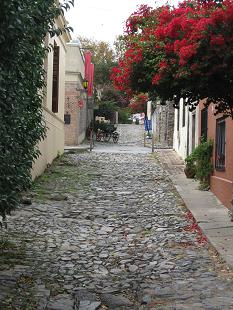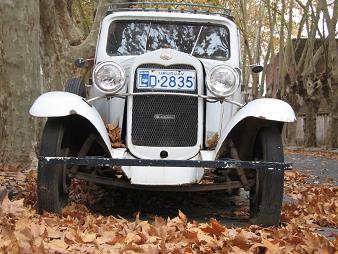Old City of Colonia
After enjoying more than a month of sunshine, we ride from Fray Bentos to Colonia del Sacramento in rain. Along the way, the temperature drops from 28 to 15C. Our textile motorcycle clothes keep us dry, thanks to the GoreTex lining, but nothing can stop the cold rain from running down sleeves and into our gloves. We turn on the heated grips and drive on with soggy but at least toasty warm hands. Warming too is the thought we have a reservation at another beautiful hotel, thanks to Fabrizio, so we arrive happy little ducks.
Next day we don our walking clothes and, under dirty grey scudding cloud and fits of wind driven showers, tour the remarkably restored old quarter of Colonia, known as Barrio Histórico (historic quarter). Good thing we have digital cameras because we can't walk 100 yards without photographing another postcard scene.
Uruguay's oldest city has a colorful and eventful past. From 1680 to 1828, it changed hands 10 times between Spanish and Portuguese interests before finally becoming part of Uruguay. What remains today are many examples from both cultures and three centuries of changing architecture.
The preservation and restoration continues today. The old city is another World Heritage Site declared by UNESCO. It's also a favorite for the folks of Buenos Aires, who can skim across the Rio del Plate in 50 minutes on a fast hydrofoil.
The stone work of buildings, old fort walls and cobblestone streets combine with late autumn flowering plants and trees still blooming to produce such charm even now that the quarter must be incredible to visit in summer.
There are plenty of examples of early 20th century stuff too. Like this Ford Victoria automobile. The strategic parking of old cars in the historic quarter must seem to an antique car fanatic a dream come true. In addition, quality antique and local craft stores abound. It is hard but we resist buying; really, where would we carry it?
Shop keepers and tourists alike bomb around town on the ubiquitous scooter. How can these decrepit old timers blend in with 300 year old buildings? We don't know, but they do.
We are fascinated by the cobblestone streets built by the Portuguese in the 17th century. Note the street has a built in gradient for a centre drain, which very cleverly removes rain water quickly to the nearby Rio del Plate.
Little remains of the original fort and walls. The gate and drawbridge still stand, proof of how it provided protected from invaders - or not, considering how often the city changed owners.










